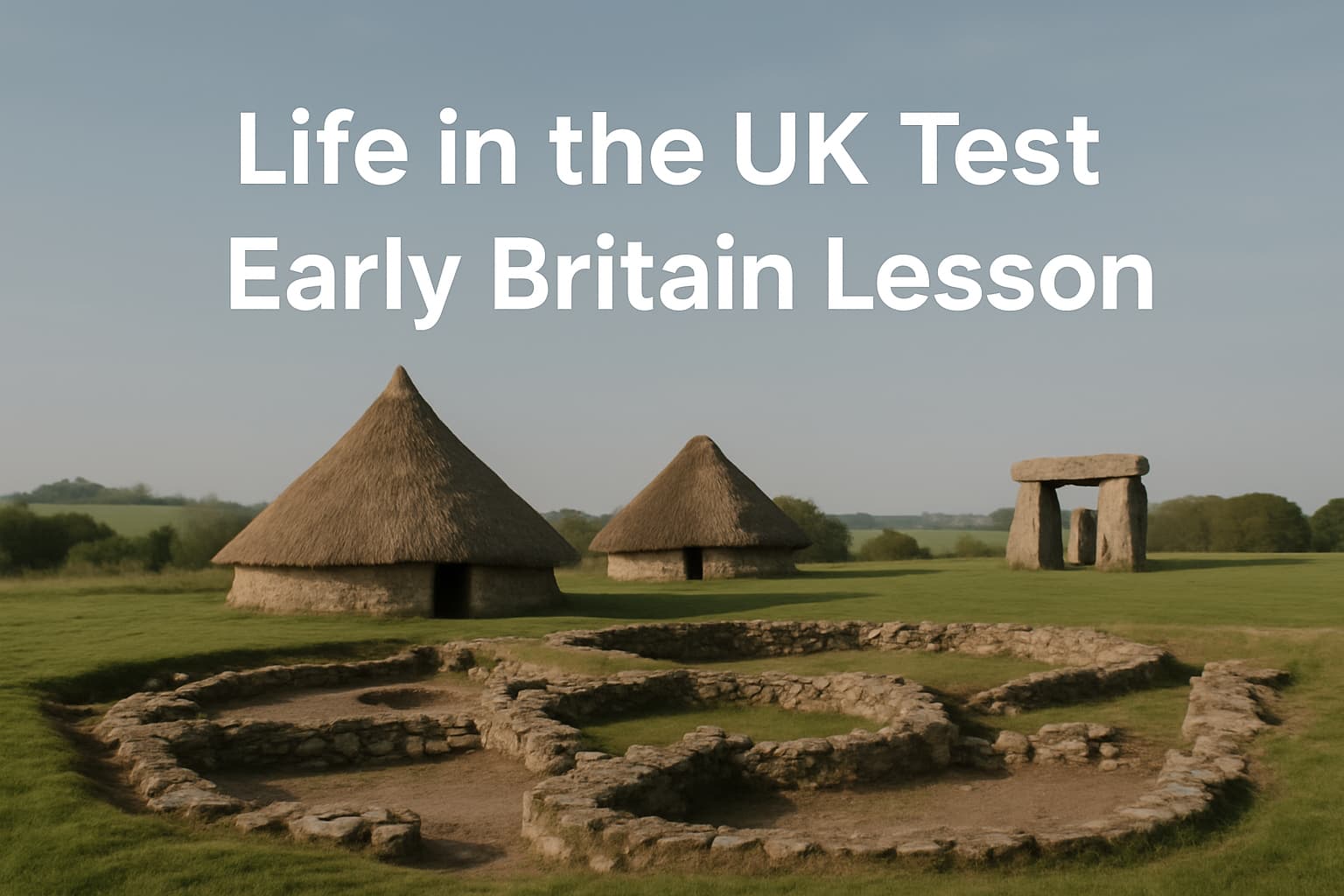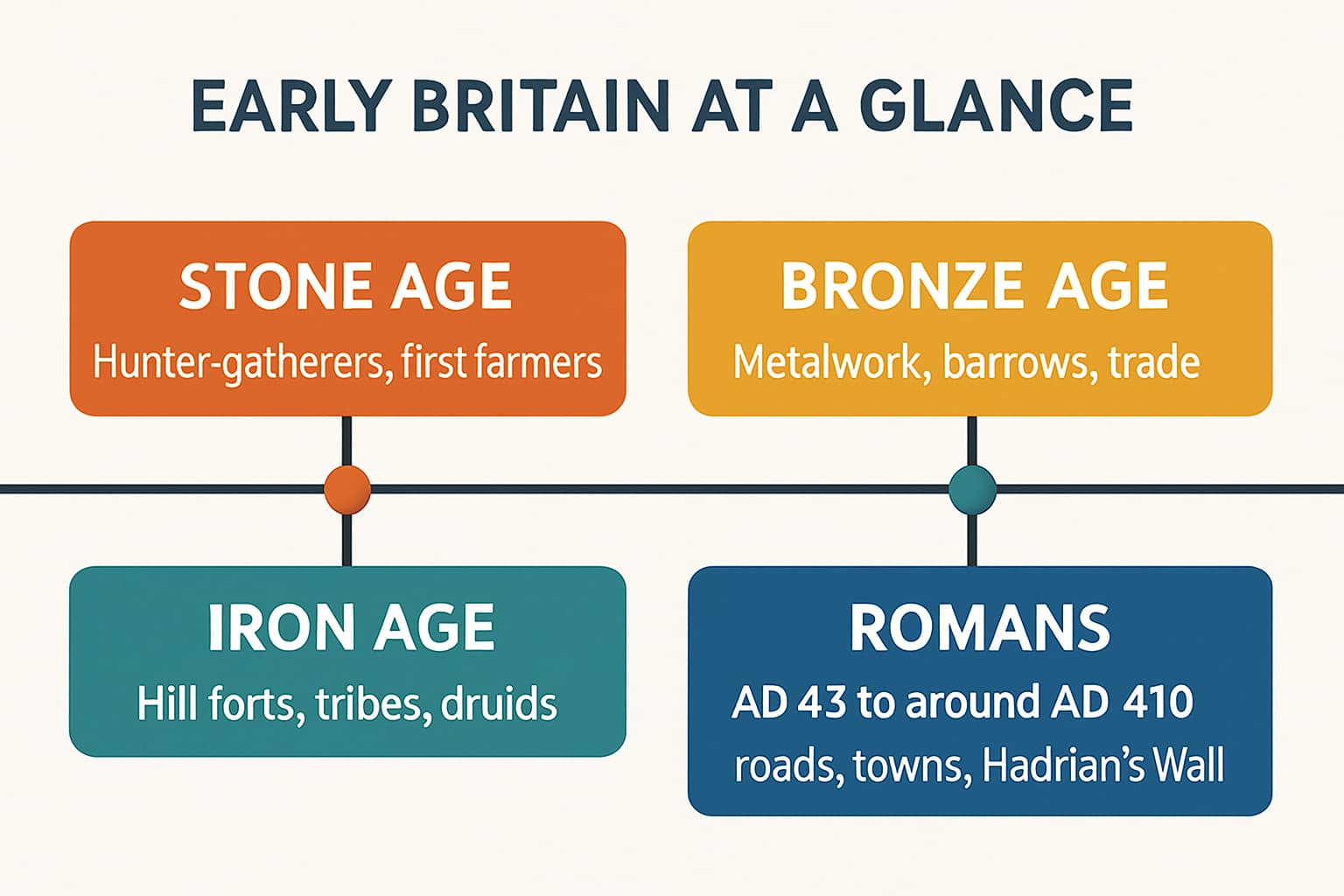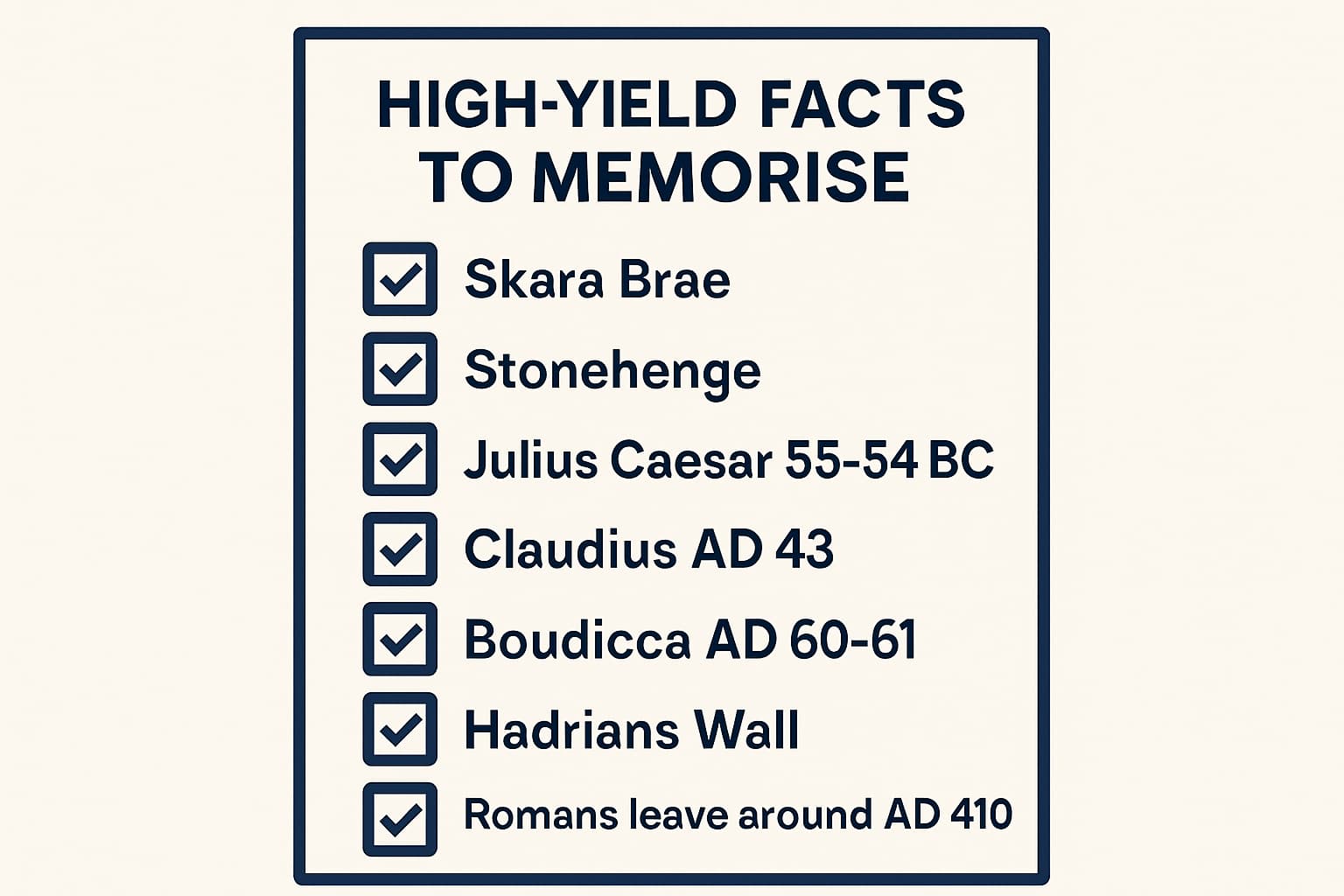Life in the UK Test: Early Britain Lesson

Struggling to remember who came first, where Hadrian’s Wall sits, or when the Romans left? This focused Early Britain lesson turns the official handbook facts into easy, test‑ready notes so you can score points quickly.
We cover exactly what the Life in the UK Test expects from the Stone Age to the end of Roman rule, with high‑yield facts, a mini‑quiz, and smart study tips using the Life in the UK Test App.
Why Early Britain matters for your Life in the UK Test
Early Britain appears throughout the official handbook (A Guide for New Residents, 3rd edition) and regularly produces straightforward, factual questions. Mastering these items is a fast way to boost your score.
- Predictable, factual items: dates, names, places, purposes.
- Compact syllabus: Stone Age to Roman withdrawal (around AD 410).
- High-yield landmarks: Skara Brae, Stonehenge, Boudicca, Hadrian’s Wall.
What “Early Britain” covers (Stone Age to Romans)
Definition: Early Britain in the Life in the UK Test spans prehistoric Britain (Stone, Bronze, Iron Ages) through the Romans in Britain, ending with their withdrawal around AD 410, as outlined in the 3rd edition handbook.
- Stone Age: hunter-gatherers, first farmers, key sites like Skara Brae and Stonehenge.
- Bronze Age: metalwork, trade, burial mounds (barrows).
- Iron Age: hill forts, tribes, Celtic languages, druids.
- Romans: Julius Caesar’s attempts, Claudius’s invasion (AD 43), Boudicca’s revolt, Hadrian’s Wall, everyday Roman life, end of rule (around AD 410).
How questions usually appear
- Dates: Which date matches Claudius’s invasion? (Answer: AD 43)
- Names: Who led the Iceni revolt? (Answer: Boudicca)
- Places: Where is Hadrian’s Wall? (Answer: in the north of England)
- Purpose: Why was Stonehenge significant? (prehistoric monument with ceremonial importance)
- Legacy: What remained after the Romans? (roads, towns, law, and Christianity)
Tip: The exam wording often mirrors the handbook. Study the exact phrasing for names and dates. For official test information, see the GOV.UK Life in the UK test overview.

Prehistoric Britain: Stone Age essentials
The handbook highlights the basics: the move from hunter-gatherer life to settled farming communities and two standout sites.
Hunter-gatherers and the first farmers
- Early settlers: People lived by hunting, fishing, and gathering.
- Neolithic shift: Farming began; people kept animals, grew crops, and built permanent settlements.
- Why it matters: Questions often ask about the lifestyle change from roaming groups to early farming villages.
Skara Brae: why it’s testable
Skara Brae, in Orkney, is a remarkably preserved Stone Age village. It reveals everyday life in early farming communities.
- Remember: Stone Age settlement in Scotland (Orkney), notable for preservation.
- Why the test asks: It’s a named site that clearly represents early domestic life.
Learn more background via Historic Environment Scotland on Skara Brae.
Stonehenge: the headline facts
- What it is: A famous prehistoric monument in Wiltshire.
- Period: Prehistoric Britain; associated with ceremonial or ritual significance.
- Why it appears: It’s a distinctive landmark the handbook names directly.
For extra context, see English Heritage: Stonehenge history.
Bronze Age Britain: metalwork, monuments, and trade
Bronze transformed tools and society. The handbook emphasizes metalworking, long-distance connections, and burials.
From stone to bronze: what changed
- New tools: Bronze axes, blades, and ornaments appeared, improving farming and craftwork.
- Trade grows: Communities exchanged metals and goods over wider areas.
- Social impact: Skills and resources became more specialized.
Burial mounds and ceremony
- Barrows: Burial mounds became common, signaling ritual practices and community organization.
- Why tested: The handbook uses barrows as a clear Bronze Age marker.
Iron Age Britain: hill forts and tribal life
The Iron Age is defined by fortified settlements, tribal societies, and religious leaders.
The Britons and Celtic languages
- Britons: The peoples living in Iron Age Britain when the Romans arrived.
- Languages: Celtic languages were spoken in different parts of the islands.
Hill forts and daily life
- Hill forts: Defensive sites on elevated ground; also community hubs.
- Economy: Farming, craft production, and local trade supported tribal life.
Druids and religion
- Druids: Religious leaders who played important roles in society.
- Beliefs: Rituals and ceremonies were part of community life.
The Romans in Britain: conquest to withdrawal
Know the sequence and the reasons events matter. Questions often test dates, names, and places from this era.
Julius Caesar’s attempts (55–54 BC)
- Why he came: Initial expeditions to Britain; contacts rather than permanent conquest.
- Legacy: Opened links with Rome but did not create lasting control.
Claudius invades (AD 43) and expansion
- Key point: Emperor Claudius led the successful Roman conquest in AD 43.
- Changes: Towns and roads were established; trade and administration expanded. London (Londinium) grew as an important town.
Boudicca’s revolt (AD 60–61)
- Leader: Boudicca of the Iceni led a major revolt against Roman rule.
- Impact: Several towns were destroyed before the Romans reasserted control.
Read more background via Historic England on Boudicca’s rebellion.
Hadrian’s Wall: purpose and legacy
- Purpose: Built under Emperor Hadrian to mark the empire’s northern frontier in England.
- Legacy: A lasting symbol of Roman Britain and a major archaeological site.
See also English Heritage: Hadrian’s Wall history.
Roman life in Britain: roads, baths, law, and faith
- Infrastructure: A network of Roman roads and towns improved travel and trade.
- Daily life: Public baths and new styles of building and living.
- Law and religion: Roman law influenced governance; Christianity began to spread.
The end of Roman rule (around AD 410)
- What happened: The Roman army left Britain around AD 410.
- Why it matters: Marks the end of Roman Britain and the close of the Early Britain section.
High‑yield facts and dates to memorise
Use this quick checklist to lock in the items the exam favors.
| Item | Remember for the test |
|---|---|
| Skara Brae | Stone Age village in Orkney; well preserved |
| Stonehenge | Prehistoric monument in Wiltshire; ceremonial |
| Julius Caesar | Attempted invasions: 55–54 BC (no lasting conquest) |
| Emperor Claudius | Successful invasion: AD 43; towns and roads |
| Boudicca | Led Iceni revolt: AD 60–61 |
| Hadrian’s Wall | Roman frontier in the north of England |
| End of Roman rule | Romans left around AD 410 |
Names and places
- Skara Brae (Orkney), Stonehenge (Wiltshire)
- Boudicca (Iceni), Hadrian’s Wall (north of England)
- London (Londinium) as a Roman town
Timeline anchors
- 55–54 BC: Julius Caesar’s attempts
- AD 43: Claudius invades
- AD 60–61: Boudicca’s revolt
- Around AD 410: Romans leave Britain

Quick practice: Early Britain mini‑quiz
Test yourself with six short items aligned to the handbook. Answers follow each question.
Questions 1–3
- Which Stone Age site in Scotland is famous for its preservation?
Answer: Skara Brae. It shows everyday life in a Neolithic settlement. - What is Stonehenge and where is it?
Answer: A prehistoric monument in Wiltshire, linked to ceremonial use. - What structure typifies Iron Age defense and community life?
Answer: Hill forts, which were both defensive and social centres.
Questions 4–6
- Who invaded successfully in AD 43?
Answer: Emperor Claudius; the Romans established towns and roads. - Who led the Iceni revolt in AD 60–61?
Answer: Boudicca. Several towns were destroyed before Rome restored control. - What was Hadrian’s Wall for, and when did Roman rule end?
Answer: It marked the northern frontier; Roman rule ended around AD 410.
Study faster with the Life in the UK Test App
Overwhelmed by dates, worried about time, or forgetting what you studied? The Life in the UK Test App streamlines Early Britain prep so you can pass on the first attempt.
- Beat overload: The complete official handbook content is optimised for mobile, focusing you on the facts that appear in questions.
- Fix weak spots: The smart assistant Brit-Bear adapts practice to your Early Britain gaps.
- Know when you are ready: A Readiness Score tracks accuracy and consistency over time.
- Practice under pressure: Hard Mode mock tests mirror real exam difficulty and timing.
- Remember more: Spaced review and detailed explanations help facts stick.
- Study anywhere: 650+ questions and offline access save precious time.
Try it now: Download on App Store or Google Play.
Brit‑Bear and your Readiness Score
Brit-Bear prioritises exactly where you miss points (for example, mixing up AD 43 vs AD 60–61), then nudges you with short sessions until your Readiness Score shows you are consistently passing.
Hard Mode mocks that feel like the real exam
Simulate exam pace and pressure with challenging question sets and strict timing so there are no surprises on test day.
650+ questions, offline access, and spaced review
Cover the syllabus thoroughly with a comprehensive question bank, study on the go without signal, and reinforce memory with spaced repetition.
Ready to lock in Early Britain? Get the app: App Store | Google Play
What comes next: Anglo‑Saxons and Vikings (1‑minute preview)
After the Romans leave, the handbook moves to Anglo‑Saxons and Vikings: the arrival and settlement of new groups, the growth of kingdoms, religious change, and later Viking raids and settlements. Study this next to continue the story into early medieval Britain.
FAQs
- What does Early Britain include in the Life in the UK Test?
- Prehistory (Stone, Bronze, Iron Ages) and Roman Britain up to the Roman withdrawal around AD 410.
- Which dates should I memorise for Early Britain?
- 55–54 BC (Caesar’s attempts), AD 43 (Claudius), AD 60–61 (Boudicca), around AD 410 (Romans leave).
- Which places are most testable?
- Skara Brae (Orkney), Stonehenge (Wiltshire), Hadrian’s Wall (north of England), and Roman London (Londinium).
- How many Early Britain questions appear on the exam?
- The exact number varies, but these items are frequent and straightforward. Focus on names, places, dates, and purposes.
- What is the best way to study Early Britain quickly?
- Memorise the four anchor dates, review the named sites, and drill timed questions. The Life in the UK Test App helps you target weak spots efficiently.